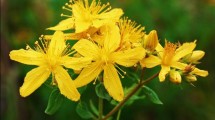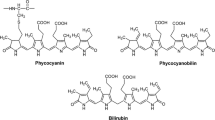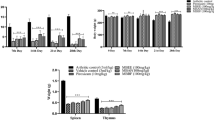Abstract
Neuroinflammation is an event that occurs in several pathologies of brain. Rubus sp. (blackberry) is a powerful antioxidant fruit, and its extract has neuroprotective activity. The aim of this study was to investigate the blackberry extract properties on lipopolysaccharide (LPS)-induced neuroinflammation, in relation to oxidative parameters and acetylcholinesterase activity in the brain structures of mice. We also investigated interleukin-10 levels in serum. Mice were submitted to Rubus sp. extract treatment once daily for 14 days. On the fifteenth day, LPS was injected in a single dose. LPS induced oxidative brain damage and the blackberry extract demonstrated preventive effects in LPS-challenged mice. LPS administration increased reactive oxygen species levels in the cerebral cortex and striatum, as well as lipid peroxidation in the cerebral cortex. However, the blackberry extract prevented all these parameters. Furthermore, LPS decreased thiol content in the striatum and hippocampus, while a neuroprotective effect of blackberry extract treatment was observed in relation to this parameter. The blackberry extract also prevented a decrease in catalase activity in all the brain structures and of superoxide dismutase in the striatum. An increase in acetylcholinesterase activity was detected in the cerebral cortex in the LPS group, but this activity was decreased in the Rubus sp. extract group. Serum IL-10 levels were reduced by LPS, and the extract was not able to prevent this change. Finally, we observed an antioxidant effect of blackberry extract in LPS-challenged mice suggesting that this anthocyanin-rich extract could be considered as a potential nutritional therapeutic agent for preventive damage associated with neuroinflammation.







Similar content being viewed by others
References
Ransohoff RM, Schafer D, Vincent A, Blachère NE, Bar-Or A (2015) Neuroinflammation: ways in which the immune system affects the brain. Neurotherapeutics 12:896–909. https://doi.org/10.1007/s13311-015-0385-3
DiSabato D, Quan N, Godbout JP (2016) Neuroinflammation: the devil is in the details. J Neurochem 139:136–153. https://doi.org/10.1111/jnc.13607
Walker AK, Kavelaars A, Heijnen CJ, Dantzer R (2014) Neuroinflammation and comorbidity of pain and depression. Pharmacol Rev 66:80–101. https://doi.org/10.1124/pr.113.008144
Quan N (2008) Immune-to-brain signaling: how important are the blood-brain barrier-independent pathways? Mol Neurobiol 37:142–152. https://doi.org/10.1007/s12035-008-8026-z
Shabab T, Khanabdali R, Moghadamtousi SZ, Kadir HA, Mohan G (2017) Neuroinflammation pathways: a general review. Int J Neurosci 127:624–633. https://doi.org/10.1080/00207454.2016.1212854
Hampel H, Mesulam MM, Cuello CA, Farlow MR, Giacobini E, Grossberg GT, Khachaturian AS, Vergallo A, Cavedo E, Snyder PJ, Khachaturian ZS (2018) The cholinergic system in the pathophysiology and treatment of Alzheimer’s disease. Brain 141:1917–1933. https://doi.org/10.1093/brain/awy132
Colovic MB, Krstic DZ, Lazarevic-Pasti TD, Bondzic AM, Vasic VM (2013) Acetylcholinesterase inhibitors: pharmacology and toxicology. Curr Neuropharmacol 11:315–335. https://doi.org/10.2174/1570159X11311030006
Tyagi E, Agrawal R, Nath C, Shukla R (2010) Effect of melatonin on neuroinflammation and acetylcholinesterase activity induced by LPS in rat brain. Eur J Pharmacol 640:206–210. https://doi.org/10.1016/j.ejphar.2010.04.041
Joshi R, Garabadu D, Teja GR, Krishnamurthy S (2014) Silibinin ameliorates LPS-induced memory deficits in experimental animals. Neurobiol Learn Mem 116:117–131. https://doi.org/10.1016/j.nlm.2014.09.006
Ammari M, Othman H, Hajri A, Sakly M, Abdelmelek H (2018) Pistacia lentiscus oil attenuates memory dysfunction and decreases levels of biomarkers of oxidative stress induced by lipopolysaccharide in rats. Brain Res Bull 140:140–147. https://doi.org/10.1016/j.brainresbull.2018.04.014
Khalili M, Alavi M, Esmaeil-Jamaat E, Baluchnejadmojarad T, Roghani M (2018) Trigonelline mitigates lipopolysaccharide-induced learning and memory impairment in the rat due to its anti-oxidative and anti-inflammatory effect. Int Immunopharmacol 61:355–362. https://doi.org/10.1016/j.intimp.2018.06.019
An J, Chen B, Kang X, Zhang R, Guo Y, Zhao J, Yang H (2020) Neuroprotective effects of natural compounds on LPS-induced inflammatory responses in microglia. Am J Transl Res 12:2353–2378
Catorce MN, Gevorkian G (2016) LPS-induced murine neuroinflammation model: main features and suitability for pre-clinical assessment of nutraceuticals. Curr Neuropharmacol 14:155–164. https://doi.org/10.2174/1570159x14666151204122017
Valli M, Bolzani VS (2019) Natural products: perspectives and challenges for use of brazilian plant species in the bioeconomy. An Acad Bras Cienc 91:e20190208. https://doi.org/10.1590/0001-3765201920190208
Carvalho FB, Gutierres JM, Bueno A, Agostinho P, Zago AM, Vieira J, Frühauf P, Cechella JL, Nogueira CW, Oliveira SM, Rizzi C, Spanevello RM, Duarte MMF, Duarte T, Dellagostin OA, Andrade CM (2016) Anthocyanins control neuroinflammation and consequent memory dysfunction in mice exposed to lipopolysaccharide. Mol Neurobiol 54:3350–3367. https://doi.org/10.1007/s12035-016-9900-8
Pacheco SM, Soares MSP, Gutierres JM, Gerzson MFB, Carvalho FB, Azambuja JH, Schetinger MRC, Stefanello FM, Spanevello RM (2018) Anthocyanins as a potential pharmacological agent to manage memory deficit, oxidative stress and alterations in ion pump activity induced by experimental sporadic dementia of Alzheimer’s type. J Nutr Biochem 56:193–204. https://doi.org/10.1016/j.jnutbio.2018.02.014
Spohr L, Soares MSP, Oliveira PS, Mattos BS, Bona NP, Pedra NS, Teixeira FC, Couto CAT, Chaves VC, Reginatto FH, Lisboa MB, Ribeiro AS, Lencina CL, Stefanello FM, Spanevello RM (2019) Combined actions of blueberry extract and lithium on neurochemical changes observed in an experimental model of mania: exploiting possible synergistic effects. Metab Brain Dis 34:605–619. https://doi.org/10.1007/s11011-018-0353-9
Chaves VC, Soares MSP, Spohr L, Teixeira F, Vieira A, Constantino LS, Dal Pizzol F, Lencina CL, Spanevello RM, Freitas MP, Simões CMO, Reginatto FH, Stefanello FM (2020) Blackberry extract improves behavioral and neurochemical dysfunctions in a ketamine-induced rat model of mania. Neurosci Lett 714:134566. https://doi.org/10.1016/j.neulet.2019.134566
Chaves VC, Calvete E, Reginatto FH (2017) Quality properties and antioxidant activity of seven strawberry (Fragaria x ananassa duch) cultivars. Sci Hortic 225:293–298. https://doi.org/10.1016/j.scienta.2017.07.013
Ali S, Lebel C, Bondy S (1992) Reactive oxygen species formation as a biomarker of methylmercury and trimethyltin neurotoxicity. Neurotoxicology 13:637–648
Stuehr D, Nathan C (1989) Nitric oxide: a macrophage product responsible for cytostasis and respiratory inhibition in tumor target cells. J Exp Med 169:1543–1555. https://doi.org/10.1084/jem.169.5.1543
Aksenov MY, Markesbery WR (2001) Changes in thiol content and expression of glutathione redox system genes in the hippocampus and cerebellum in Alzheimer’s disease. Neurosci Lett 302:141–145. https://doi.org/10.1016/s0304-3940(01)01636-6
Esterbauer H, Cheeseman KH (1990) Determination of aldehydic lipid peroxidation products: malonaldehyde and 4-hydroxynonenal. Methods Enzymol 186:407–421. https://doi.org/10.1016/0076-6879(90)86134-H
Misra HP, Fridovich I (1972) The role of superoxide anion in the autoxidation of epinephrine and a simple assay for superoxide dismutase. J Biol Chem 247:3170–3175
Aebi H (1984) Catalase in vitro. Methods Enzymol 105:121–126. https://doi.org/10.1016/S0076-6879(84)05016-3
Ellman GL, Courtney KD, Andres V, Featherstone RM (1961) A new and rapid colorimetric determination of acetylcholinesterase activity. Biochem Pharmacol 17:88–95. https://doi.org/10.1016/0006-2952(61)90145
Lowry OH, Rosebrough NJ, Farr AL, Randall RJ (1951) Protein measurement with the Folin phenol reagent. J Biol Chem 193:265–275
Bradford M (1976) A rapid and sensitive method for the quantitation of microgram quantities of protein utilizing the principle of protein-dye binding. Anal Biochem 72:248–254. https://doi.org/10.1016/0003-2697(76)90527-3
Sankowski R, Mader S, Valdés-Ferrer SI (2015) Systemic inflammation and the brain: novel roles of genetic, molecular, and environmental cues as drivers of neurodegeneration. Front Cell Neurosci 9:28. https://doi.org/10.3389/fncel.2015.00028
Wang J, Song Y, Chen Z, Leng SX (2018) Connection between systemic inflammation and neuroinflammation underlies neuroprotective mechanism of several phytochemicals in neurodegenerative diseases. Oxid Med Cell Longev 2018:1972714. https://doi.org/10.1155/2018/1972714
Haddad JJ, Fahlman CS (2002) Redox- and oxidant-mediated regulation of interleukin-10: an anti-inflammatory, antioxidant cytokine? Biochem Biophys Res Commun 297:163–176. https://doi.org/10.1016/s0006-291x(02)02094-6
Akarsu ES, Mamuk S (2007) Escherichia coli lipopolysaccharides produce serotype-specific hypothermic response in biotelemetered rats. Am J Physiol Regul Integr Comp Physiol 292:R1846–R1850. https://doi.org/10.1152/ajpregu.00786.2006
Mao X, Sarkar S, Chang SL (2013) Involvement of the NLRP3 inflammasome in the modulation of an LPS-induced inflammatory response during morphine tolerance. Drug Alcohol Depend 132:38–46. https://doi.org/10.1016/j.drugalcdep.2012.12.022
Yuan Z, Zhang H, Hasnat M, Ding J, Chen X, Liang P, Sun L, Zhang L, Jiang Z (2019) A new perspective of triptolide-associated hepatotoxicity: liver hypersensitivity upon LPS stimulation. Toxicology 15(414):45–56. https://doi.org/10.1016/j.tox.2019.01.005
Fischer R, Maier O (2015) Interrelation of oxidative stress and inflammation in neurodegenerative disease: role of TNF. Oxid Med Cell Longev 2015:610813. https://doi.org/10.1155/2015/610813
Spencer JP, Vafeiadou K, Williams RJ, Vauzour D (2012) Neuroinflammation: modulation by flavonoids and mechanisms of action. Mol Aspects Med 33:83–97. https://doi.org/10.1016/j.mam.2011.10.016
Vauzour D (2014) Effect of flavonoids on learning, memory and neurocognitive performance: relevance and potential implications for Alzheimer’s disease pathophysiology. J Sci Food Agric 94:1042–1056. https://doi.org/10.1002/jsfa.6473
Forman HJ, Davies KJA, Ursini F (2014) How do nutritional antioxidants really work: nucleophilic tone and para-hormesis versus free radical scavenging in vivo. Free Radic Biol Med 66:24–35. https://doi.org/10.1016/j.freeradbiomed.2013.05.045
Amin FU, Shah SA, Badshah H, Khan M, Kim MO (2017) Anthocyanins encapsulated by PLGA@PEG nanoparticles potentially improved its free radical scavenging capabilities via p38/JNK pathway against Aβ 1–42-induced oxidative stress. J Nanobiotechnology 15:12. https://doi.org/10.1186/s12951-016-0227-4
Bal-Price A, Matthias A, Brown GC (2002) Stimulation of the NADPH oxidase in activated rat microglia removes nitric oxide but induces peroxynitrite production. J Neurochem 80:73–80. https://doi.org/10.1046/j.0022-3042.2001.00675.x
Brown GC, Bal-Price A (2003) Inflammatory neurodegeneration mediated by nitric oxide, glutamate, and mitochondria. Mol Neurobiol 27:325–355. https://doi.org/10.1385/MN:27:3:325
Kalt W, Blumberg JB, McDonald JE, Vinqvist-Tymchuk MR, Fillmore SA, Graf BA, O’Leary JM, Milbury PE (2008) Identification of anthocyanins in the liver, eye, and brain of blueberry-fed pigs. J Agric Food Chem 56:705–712. https://doi.org/10.1021/jf071998l
Spohr L, Luduvico KP, Soares MSP, Bona NP, Oliveira PS, de Mello JE, Alvez FL, Teixeira FC, Felix AOC, Stefanello FM, Spanevello RM (2020) Blueberry extract as a potential pharmacological tool for preventing depressive-like behavior and neurochemical dysfunctions in mice exposed to lipopolysaccharide. Nutr Neurosci 21:1–14. https://doi.org/10.1080/1028415X.2020.1819104
Maurer SV, Williams CL (2017) The cholinergic system modulates memory and hippocampal plasticity via its interactions with non-neuronal cells. Front Immunol 8:1489. https://doi.org/10.3389/fimmu.2017.01489
Khan H, Marya AS, Kamal MA, Patel S (2018) Flavonoids as acetylcholinesterase inhibitors: current therapeutic standing and future prospects. Biomed Pharmacother 101:860–870. https://doi.org/10.1016/j.biopha.2018.03.007
Pacheco SM, Azambuja JH, de Carvalho TR, Soares MSP, Oliveira PS, da Silveira EF, Stefanello FM, Braganhol E, Gutierres JM, Spanevello RM (2018) Glioprotective effects of lingonberry extract against altered cellular viability, acetylcholinesterase activity, and oxidative stress in lipopolysaccharide-treated astrocytes. Cell Mol Neurobiol 38:1107–1121. https://doi.org/10.1007/s10571-018-0581-x
Acknowledgements
This research was supported by the Brazilian funding agencies CNPq, CAPES and FAPERGS. This study was financed in part by CAPES—Finance code 001. VCC, KPL, FHR and CMOS were also grateful for their research fellowships (CNPq).
Author information
Authors and Affiliations
Corresponding author
Ethics declarations
Conflict of interest
The authors declare that there are no conflicts of interest.
Ethical Approval
The protocols were approved by the Committee of Ethics and Animal Experimentation of the Federal University of Pelotas, RS, Brazil (protocol number: CEEA 3781/2017). All animal experiments were carried out in accordance with the National Institutes of Health guidelines for the care and use of Laboratory animals (NIH Publications No. 8023, revised 1978).
Additional information
Publisher's Note
Springer Nature remains neutral with regard to jurisdictional claims in published maps and institutional affiliations.
Rights and permissions
About this article
Cite this article
Soares, M.S.P., Luduvico, K.P., Chaves, V.C. et al. The Protective Action of Rubus sp. Fruit Extract Against Oxidative Damage in Mice Exposed to Lipopolysaccharide. Neurochem Res 46, 1129–1140 (2021). https://doi.org/10.1007/s11064-021-03248-7
Received:
Revised:
Accepted:
Published:
Issue Date:
DOI: https://doi.org/10.1007/s11064-021-03248-7




